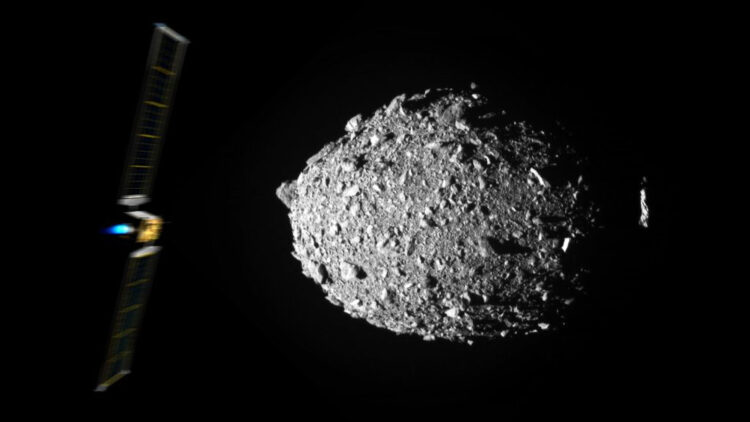Two years ago, NASA’s Double Asteroid Redirection Test (DART) spacecraft made history by colliding with an asteroid moon. This ambitious mission aimed to investigate methods to divert dangerous asteroids that could threaten planet Earth. Recent research has now shown that the collision not only changed the orbit of the impacted celestial body but also dramatically altered its shape, fundamentally reshaping our understanding of these astronomical objects.
NASA’s DART mission: A breakthrough in asteroid collision impact theory
On September 26, 2022, DART intentionally collided with Dimorphos, a 560-foot-wide asteroid moon that orbits a larger asteroid known as Didymos.
The impact was more profound than expected, resulting in Dimorphos shifting from a roughly symmetrical shape to a more elongated form resembling an oblong watermelon. Initially, Dimorphos had an oblate spheroid shape; afterwards, however, it became what is described as a “triaxial ellipsoid.”
The collision also caused Dimorphos’ orbit to spiral inward, thus reducing its orbital period by 33 minutes and 15 seconds—from 11 hours and 55 minutes to around 11 hours and 22 minutes. This process is known to have changed the gravitational dynamics between Dimorphos and Didymos, as the two bodies are closely interconnected.
This disruption in equilibrium also led to a slight increase in Dimorphos’ density, which now orbits Didymos at a distance of approximately 3,780 feet, roughly 120 feet closer than before the collision.
How DART’s collision altered asteroid behavior and stability
Per a new study conducted by Derek Richardson, an astronomer at the University of Maryland, these developments have important implications for the future exploration of asteroids.
For example, the unexpected changes in Dimorphos’ shape and motion indicate that it may be undergoing chaotic tumbling as it seeks a new gravitational equilibrium with Didymos. This instability raises questions about the feasibility of landing spacecraft on Dimorphos for further research.
“It could take a hundred years to see noticeable changes in the system, but it’s only been a few years since the impact,” Richardson explains. “Learning about how long it takes Dimorphos to regain its stability tells us important things about its internal structure, which in turn informs future attempts to deflect hazardous asteroids.”
Lessons from DART: What this means for future asteroid deflection missions
According to another study conducted by JPL—a division of Caltech—the findings are derived from three primary data sources.
Firstly, images from DART during its approach provided the initial metrics on both asteroids. Secondly, the Goldstone Solar System Radar measured changes in position and velocity following the impact. Finally, ground-based telescopes tracked variations in the light reflecting off the asteroids, allowing scientists to monitor their altered orbits with remarkable precision.
Interestingly, Didymos, the larger asteroid, maintained its shape, which indicates that it can withstand significant alterations. As for Dimorphos, it’s thought to be a “rubble pile” object, akin to asteroid Bennu. With these observations in mind, it creates new research opportunities regarding the formation, composition, and evolution of these celestial bodies.
Anticipation is building for the European Space Agency’s Hera mission, which is set for launch in late 2026. It will carry out an in-depth examination of the asteroids affected by DART, collecting crucial data about their internal structures and the long-term effects of the impact. In the process, it can validate asteroid deflection as an effective defense strategy.
The groundbreaking results from NASA’s DART mission not only reshaped Dimorphos, but also our approach to asteroid research. As we await the Hera mission’s insights, we stand on the brink of a new era in planetary defense. Ultimately, this will enhance our understanding of these astronomical objects and empower us to protect Earth.

